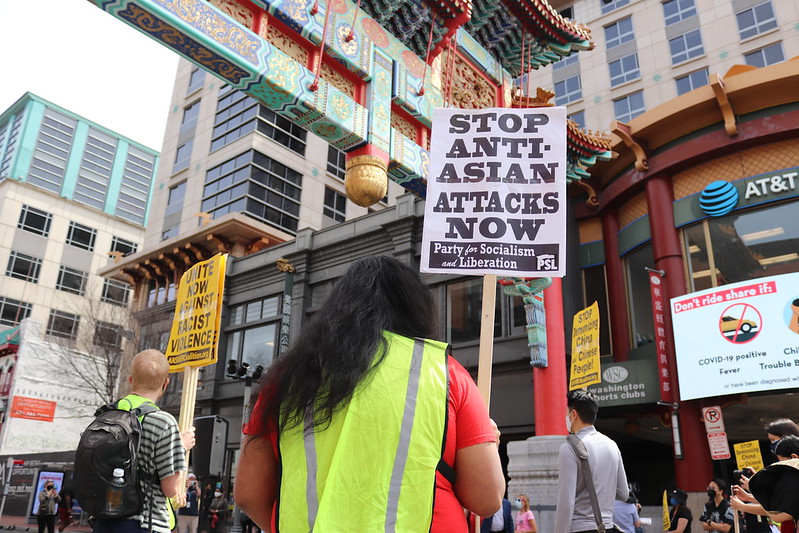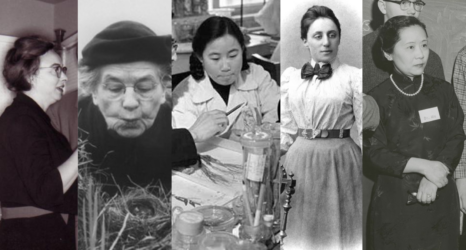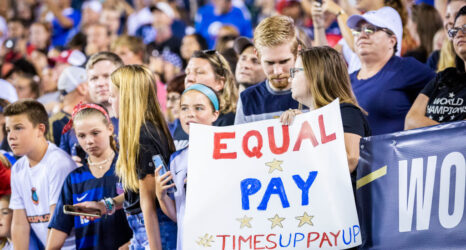As a person who runs a national organization and does a lot of public speaking and writing, I shouldn’t feel invisible—but I often do. Even when, a few years back the New York Times Magazine ran a cover story about, mostly, me.
Because here’s what that story said: that I lead by indirection. That I “sweetly, profusely and genuinely” thank people for recommending ideas that I already know—and which sometimes are, in fact, mine.
“Men of bulk in loosened ties have a way of talking at her for hours and then lifting her best notions, as if accidentally choosing a nicer umbrella on the way out of a restaurant.”
It’s funny, but it isn’t. I spend a lot of time making sure other people get credit. But today, when anti-Asian hatred is both roiling and confounding America, how I show up—and why, and whether that should change—is on my mind.
Now, my way of operating can get results. I’ve been part of progressive politics for decades, and I’ve learned that you can get a lot done when you don’t care about limelight. I want to move new ideas to the very center of politics—a new sense of how government can power the economy, a deeper agenda for racial justice. Helping other people do great things is a pretty effective way to get great things done. And, if I am being honest, it’s comfortable for me.
But maybe I need to get a little more uncomfortable—to think harder about what it means to be an Asian American woman in politics, to call things out through my particular lens.
Because we have no real language to describe what is happening to Asians in America today. As Jay Caspian Kang says, we need to put a name to this violence. In March, a 21-year-old white man in Atlanta killed eight people, including six Asian women. Talking heads spent more time debating what the Atlanta shooting really was—was it a hate crime? maybe it was misogyny, or a vulnerable mind warped by repressive religious fundamentalism—than they did mourning.
Even our hashtags make little sense. Why is it #StopAsianHate? We Asians are not the ones doing most of the hating.

Non-Asians—meaning 94 percent of Americans—pay attention when anti-Asian sentiment in the U.S. turns violent. But alongside these violent punctuations is something ever-present, a sense of otherness that is subterranean and pervasive. Being made to feel vaguely alien in your own country is not something that most white people think about. But for Asians, being asked “but where are you really from?” is irritating—a shared, eye-roll-inducing joke. Being called some other Asian woman’s name is worse. (Yes, this has happened to me more often than you’d think—once by my boss, once by the federal government in a print announcement that I’d gotten an executive branch appointment.)
Now, these are not the most profound of all injustices. But they add to the notion that Asian identity is elusive, vaporous. That evanescence is itself the problem. And with this seems to come a doubting of Asian America that does make me angry: the fundamental questioning of whether Asian America exists. Even our own writers start with the notion that ours is a muddled history, that we inhabit an in-between space.
I have never thought that Asian America was all that confusing. But today, everyone seems to lead with questions: What is Asian America? Does it have a hyphen? Who counts?
I have different questions. The fight for greater racial inclusion and more racial justice is at the heart of my political work, so I often use the terms “people of color” or “Black and brown” or, more recently, “BIPOC.” But these days I am not quite sure: do any of these designations include me?
My Story
I have learned, far too recently, that these things go together: my behind-the-scenes indirection, which reads as “sweet” even when it’s purposeful. The lack of language to describe many Americans’ suspicion of Asian people—which can become vitriolic and violent, especially when egged on by Donald Trump’s weaponized “China virus” or “kung flu.” The inability to say definitively whether Asians are, or are not, people of color. All of this can leave us as people without solidarities. Sometimes we are called “Asian allies.” I am beyond proud to have the chance to be an ally to Black and brown people, and I hope I can be an effective one. But who will be my ally, and can they be an ally on my terms?
Invisibility can come from a lack of clarity. So let me be clear: Asian America is diverse—but that doesn’t make it inscrutable.
My contribution to clarity begins with my own story.
My father, now in his 80s, grew up in Augusta, Ga., at the height of Jim Crow. His family—his mother, his uncle and five kids—lived in a single room at the back of their 200-square-foot grocery store. His best friends were Boykin and Cush Cade, Black brothers who lived down the street. But the Cade brothers went to one school and my father and his siblings went to another, because the Augusta city government—not knowing exactly how to classify Chinese families at a time when the law classified everyone by race—deemed Chinese people to be “honorary white.” My dad and his family moved to Oakland, California in the 1950s, in parallel to the Great Migration, similarly catalyzed by the racialized economic dead end life my grandmother knew in the Deep South.
My mother’s mother, Gee Suey Ting, became a paper sister to her own husband, Gee Seow Hong, who had moved to America in the 1920s in search of work. My grandmother and her American-born children, including my mom, falsely took the name of a man, Shen Wong, who signed courthouse papers attesting to a fake marriage. This is because the 1882 Chinese Exclusion Act forbid Chinese women to come to America with their husbands. The official policy of the United States through much of the early 20th century was to deny Chinese people the right to have a family.
My parents grew up as working kids of the working class in postwar America, my mom waiting tables in her parent’s Great China restaurant, my dad driving a Ford pickup truck to deliver groceries around Oakland. My aunts were house girls, cleaning for white families or marrying Chinatown boys whose mothers treated them like servants.
My mom and dad got luckier, mostly because they fought for more. They went to UC Berkeley, beneficiaries of a truly free higher education, the best of pre-neoliberal public investments. That meant a kind of mobility for my brother and me. We grew up in Sunnyvale, California. In 1970, according to the official census, Sunnyvale had 95,408 residents, of whom 1,273, or 1.3 percent, were Chinese.
Mine was a suburban childhood. My friends were mostly white, but my best friends were the Dare sisters (“Dare” being an anglicization of a Cantonese surname) whose mom made yeow jah gwai and layered mandarin orange jello salad for once-a-week family dinners. I dreaded Friday night Chinese school because I could never understand what anyone was saying. I tried not to let it bother me when boys in elementary school asked why my nose was so flat, or when my brother’s entire class, his sophomore year of high school, decided to dress up as Japanese tourists—complete with neck-strap cameras, Hawaiian shirts, buck teeth and fake-slanted eyes—and throw water balloons at each other in some perverted homecoming skit play-acting Pearl Harbor and Hiroshima.
My uncles and aunts weren’t suburban. They knew more about radicalism. My Aunt Nell went to SF State and became a feminist poet, union organizer, and founding member of the Freedom Socialist party. My Uncle Bill hung out with Frank Chin and the guys who wrote Aiiieeeee! in the ‘70s. Bill wrote Yellow Journalist: Dispatches from Asian America, decades ago. He was ahead of his time. I now run the Roosevelt Institute but when I was a kid, the only thing I knew about Franklin Roosevelt was that he put the Japanese in camps.
The Politics of Space
Today, I think a lot about the 1970s and those early days of Yellow Power. That push-pull is what Asian America means to me. In white spaces, the feeling of kinship, rarely spoken, with others who are also part of the vast South and East Asian diaspora. The struggle with whether to be louder, more radical. And the quiet desire to remind others—who might default to thinking of Asians as people who flew to the US to take tech jobs or go to medical schools—that my people also knew cutting, humiliating poverty. I will admit to totally loving Crazy Rich Asians. I saw it twice the summer it came out. But crazy rich is far from the sum total of Asian America.
At a time when anti-Asian-ness ranges from white suspicion to murder, it is time for us to be visible. Our claim is different than the demand from Black communities, for wealth reparations given all that has been stolen from them for centuries, or for radical reform of racist policing. But the Asian claim for true recognition of our lives as we live them, and not as model-minorities or white-adjacent, must also be part of the long path towards justice.
Been to a few rallies, protests and marches in my life. Wouldn’t have missed out the chance to speak up for myself. #StopAsianHate DC rally. #StopAAPIHate pic.twitter.com/FgkKcADFJJ
— Vicky Wang (@VickyAndiWang) March 21, 2021
Even now, when the shock of daily, headline-making violence opens the door to that kind of recognition, and also a deeper and more real cross-racial solidarity, stepping into the center is more difficult than one might imagine. Asians, as Cathy Park Hong says, take up apologetic space. This stance, to lead with demurring, is hard to unlearn. Even today, I have to remind myself that it is ok to be more than the moderator, maybe even to be the expert, at an event that that features my work.
But if I take up too much space in any direction, I am not the only one who is uncomfortable. White-adjacentness is a huge part of white supremacy, silent and too little acknowledged. Being neither white nor Black boxes you in with white people and with Black people alike. Defaulting to helpful indirection is easy for me, and might even be smart—I will probably keep doing it long after this article runs—but is also painful in its perfect, neatly clipped performance of gender and race.
I suspect this is the burden of many Asian women. Even for me, after so many years of doing the work, it is hard to distinguish between strategic indirection and the disappearance that comes from defaulting to never making waves, always fitting in.
Andrew Yang, former presidential candidate and now frontrunner for mayor of New York, was wrong when he said the answer to anti-Asian hatred is for Asian Americans to “embrace and show our Americanness in ways we never have before … We should show without a shadow of a doubt that we are Americans who will do our part for our country in this time of need.”
Wait. What are we proving, and to whom? No. The answer to anti-Asian hatred is Asian power—the power that comes from fighting for a racial justice that includes us, fully visible.
You may also like:












